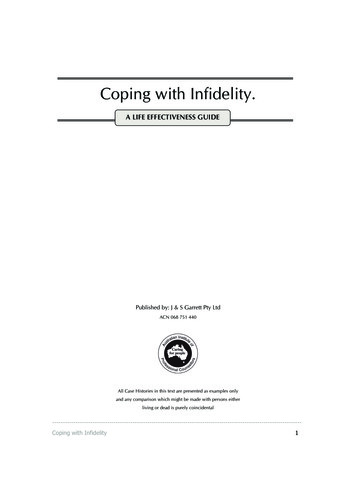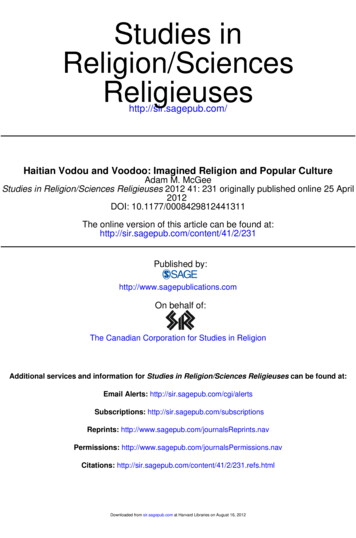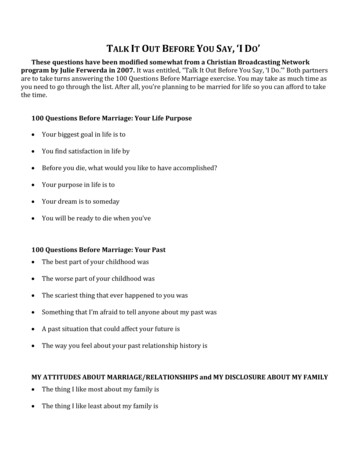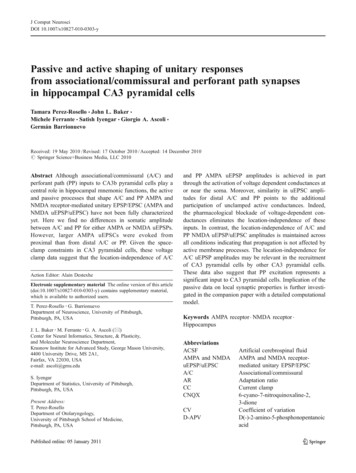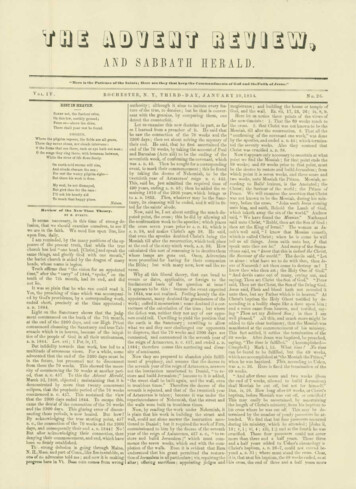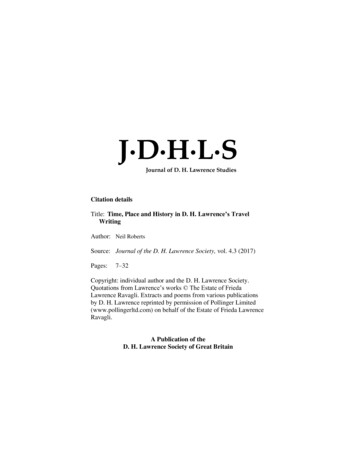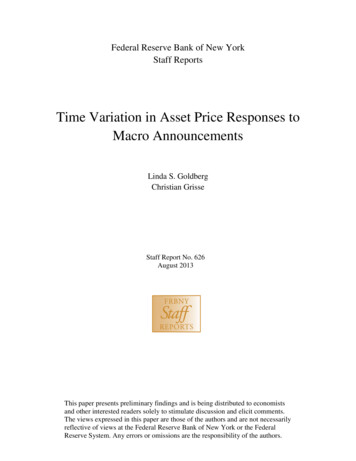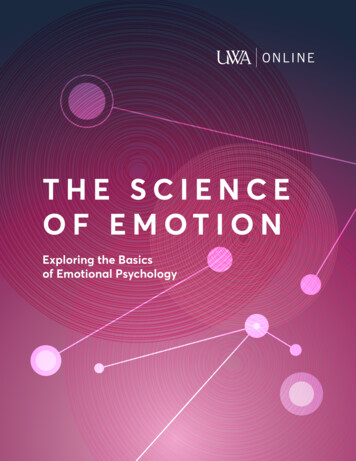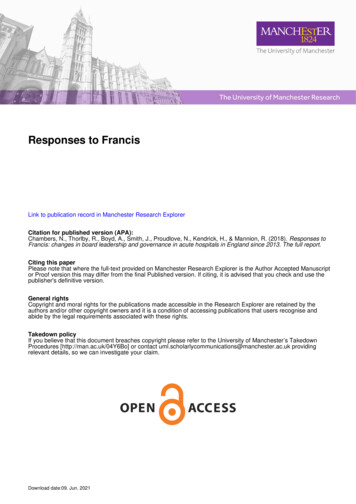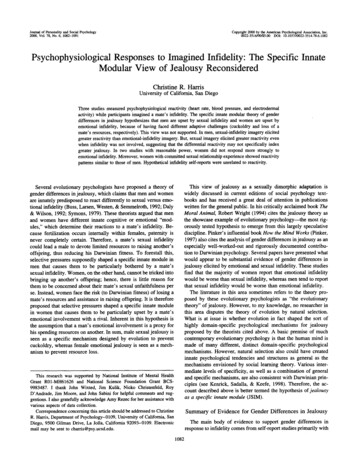
Transcription
Journal of Personality and Social Psychology2000, Vol. 78, No. 6, 1082-1091Copyright 2000 by the American Psychological Association, Inc.OO22-3514/OO/S5.OO DOI: 10.1037//0022-3514.78.6.1082Psychophysiological Responses to Imagined Infidelity: The Specific InnateModular View of Jealousy ReconsideredChristine R. HarrisUniversity of California, San DiegoThree studies measured psychophysiological reactivity (heart rate, blood pressure, and electrodermalactivity) while participants imagined a mate's infidelity. The specific innate modular theory of genderdifferences in jealousy hypothesizes that men are upset by sexual infidelity and women are upset byemotional infidelity, because of having faced different adaptive challenges (cuckoldry and loss of amate's resources, respectively). This view was not supported. In men, sexual-infidelity imagery elicitedgreater reactivity than emotional-infidelity imagery. But, sexual imagery elicited greater reactivity evenwhen infidelity was not involved, suggesting that the differential reactivity may not specifically indexgreater jealousy. In two studies with reasonable power, women did not respond more strongly toemotional infidelity. Moreover, women with committed sexual relationship experience showed reactivitypatterns similar to those of men. Hypothetical infidelity self-reports were unrelated to reactivity.Several evolutionary psychologists have proposed a theory ofgender differences in jealousy, which claims that men and womenare innately predisposed to react differently to sexual versus emotional infidelity (Buss, Larsen, Westen, & Semmelroth, 1992; Daly& Wilson, 1992; Symons, 1979). These theorists argued that menand women have different innate cognitive or emotional "modules," which determine their reactions to a mate's infidelity. Because fertilization occurs internally within females, paternity isnever completely certain. Therefore, a mate's sexual infidelitycould lead a male to devote limited resources to raising another'soffspring, thus reducing his Darwinian fitness. To forestall this,selective pressures supposedly shaped a specific innate module inmen that causes them to be particularly bothered by a mate'ssexual infidelity. Women, on the other hand, cannot be tricked intobringing up another's offspring; hence, there is little reason forthem to be concerned about their mate's sexual unfaithfulness perse. Instead, women face the risk (to Darwinian fitness) of losing amate's resources and assistance in raising offspring. It is thereforeproposed that selective pressures shaped a specific innate modulein women that causes them to be particularly upset by a mate'semotional involvement with a rival. Inherent in this hypothesis isthe assumption that a man's emotional involvement is a proxy forhis spending resources on another. In sum, male sexual jealousy isseen as a specific mechanism designed by evolution to preventcuckoldry, whereas female emotional jealousy is seen as a mechanism to prevent resource loss.This view of jealousy as a sexually dimorphic adaptation iswidely discussed in current editions of social psychology textbooks and has received a great deal of attention in publicationswritten for the general public. In his critically acclaimed book TheMoral Animal, Robert Wright (1994) cites the jealousy theory asthe showcase example of evolutionary psychology—the most rigorously tested hypothesis to emerge from this largely speculativediscipline. Pinker's influential book How the Mind Works (Pinker,1997) also cites the analysis of gender differences in jealousy as anespecially well-worked-out and rigorously documented contribution to Darwinian psychology. Several papers have presented whatwould appear to be substantial evidence of gender differences injealousy elicited by emotional and sexual infidelity. These studiesfind that the majority of women report that emotional infidelitywould be worse than sexual infidelity, whereas men tend to reportthat sexual infidelity would be worse than emotional infidelity.The literature in this area sometimes refers to the theory proposed by these evolutionary psychologists as "the evolutionarytheory" of jealousy. However, to my knowledge, no researcher inthis area disputes the theory of evolution by natural selection.What is at issue is whether evolution in fact shaped the sort ofhighly domain-specific psychological mechanisms for jealousyproposed by the theorists cited above. A basic premise of muchcontemporary evolutionary psychology is that the human mind ismade of many different, distinct domain-specific psychologicalmechanisms. However, natural selection also could have createdinnate psychological tendencies and structures as general as themechanisms envisioned by social learning theory. Various intermediate levels of specificity, as well as a combination of generaland specific mechanisms, are also consistent with Darwinian principles (see Kenrick, Sadalla, & Keefe, 1998). Therefore, the account described above is better termed the hypothesis of jealousyas a specific innate module (JSIM).This research was supported by National Institute of Mental HealthGrant R01-MH61626 and National Science Foundation Grant BCS9983487. I thank John Wixted, Jim Kulik, Nicko Christenfeld, RoyD'Andrade, Jim Moore, and John Sabini for helpful comments and suggestions. I also gratefully acknowledge Amy Rezec for her assistance withvarious aspects of data collection.Correspondence concerning this article should be addressed to ChristineR. Harris, Department of Psychology-0109, University of California, SanDiego, 9500 Gilman Drive, La Jolla, California 92093-0109. Electronicmail may be sent to charris@psy.ucsd.edu.Summary of Evidence for Gender Differences in JealousyThe main body of evidence to support gender differences inresponse to infidelity comes from self-report studies primarily with1082
JEALOUSY: PHYSIOLOGICAL RESPONSES RECONSIDEREDcollege students. In a typical study, men and women are asked toimagine a committed sexual relationship that they have had orwould like to have. Participants then choose which form of infidelity would be most upsetting: their mate (a) falling in love withsomeone else or (b) having sexual intercourse with someone else.Almost all of the researchers that have used this forced-choicemethod have found a significant gender difference (e.g., Bailey,Gaulin, Agyei, & Gladue, 1994; Buss et al., 1992; DeSteno &Salovey, 1996; Harris & Christenfeld, 1996a). In the United States,the clear majority of women report that they would be morebothered by emotional infidelity, ranging from approximately 62%(DeSteno & Salovey, 1996) to 86% (Buss et al., 1992). However,at most only a slight majority of men say they would be morebothered by sexual infidelity, ranging from 47% (Harris & Christenfeld, 1996a) to 60% (Buss et al., 1992). Using slightly differentquestions, Wiederman and Allgeier (1993) also found genderdifferences.However, it should be noted that not all self-report studies havesupported the JSIM view. Gender differences frequently are notfound when participants use continuous ratings scales to estimatehow upset they would expect to be over each form of infidelity(DeSteno & Salovey, 1996; Harris, 2000b). Also, in two studies,more women than men predicted that they would verbally orphysically aggress against a rival or a mate in response to sexualbetrayal (de Weerth & Kalma, 1993; Paul & Galloway, 1994).Moreover, in two studies with reasonable power, male and femalecollege students who had experienced a mate's infidelity did notsignificantly differ in their assessment of how damaging sexualinfidelity was to their primary relationship (Hansen, 1987) or intheir amount of focus on the sexual and emotional aspects of theinfidelity (Harris, 2000b).A particularly influential and widely cited study examined physiological rather than subjective measures of emotional reactions.Buss et al. (1992) had U.S. college students imagine both a mateengaging in sexual intercourse with someone else and a matefalling in love with another person, while heart rate (HR), electrodermal activity (EDA), and electromyographic activity of the brow(EMG) were measured. This study has been claimed to provide(Buss, 1995; Pinker, 1997; Wright, 1994) unequivocal support forthe JSIM hypothesis: Men showed greater reactivity to the imagined sexual infidelity, whereas women showed greater reactivity tothe imagined emotional infidelity.However, an examination of the data from the original articlesuggests the results are not quite so clear-cut. Buss et al. (1992)used a series of three t tests to analyze the data for each genderseparately. Men showed significantly more EDA during the sexualscenario (1.30 microsiemen) than during the emotional scenario(-0.11 microsiemen). Women showed more EDA during the emotional scenario (0.21 microsiemen) than during the sexual scenario(-0.07 microsiemen). Heart rate, measured in beats per minute(bpm), provided mixed results. A significant difference in thepredicted direction was found for men (4.76 bpm for sexualvs. 3.00 bpm for emotional scenario) but not for women (2.25 bpmfor sexual vs. 2.57 bpm for emotional scenario). Analyses of browEMG activity did not show significant differences for either gender (although the means were generally in the direction predictedby the JSIM model).1083Limitations of the Existing Physiological DataWhat should be concluded from the Buss et al. (1992) physiological data? Evidently, men show more physiological reactivity toimagined sexual infidelity than to emotional infidelity. Althoughthere are signs that women show the opposite pattern, the data areweak for a couple of reasons. First, only one out of three physiological measures showed a significant difference. Second, themagnitude of the difference between imagining sexual infidelityand imagining romantic infidelity is much weaker for women thanfor men. The smaller difference scores for women do not appear tobe due to a ceiling effect; women did not show much autonomicreactivity while imaging either infidelity scene. For example,women showed less heart rate response to the emotional infidelityscenario than did men. From the standpoint of JSIM, the tenuousdifferences in physiological reactivity of women to the two formsof infidelity are puzzling, given the self-report data presented byseveral researchers (Buss et al., 1992; DeSteno & Salovey, 1996;Harris & Christenfeld, 1996a). This issue will be further addressedin the General Discussion.Differential Reactivity and Emotional StatesA key assumption of Buss and colleagues (Buss et al., 1992) isthat the increases in physiological activity were indicative ofemotional distress over infidelity. This need not be the case, asEDA and HR show increases across a number of emotional states.A complete review of the evidence that different emotional statesare accompanied by distinctive patterns of autonomic reactivity isbeyond the scope of this article. However, a few points should benoted. First, studies to date have found only a limited set ofautonomic differences among a small set of emotions. Furthermore, these differences are often subtle. For example, fear, anger,and happiness all produce accelerated HR; fear and disgust produce larger EDA increases than does happiness, but these increaseshave not been distinguished from that of sexual reactivity. (Ax,1953; Levenson, 1992; Schwartz, Weinberger, & Singer, 1981;Zuckerman, 1971). Second, although Buss et al. wrote about thedistress associated with jealousy, there is no consensus on theexact nature of that distress. Jealousy may be a discrete emotion,or a blend of several emotions simultaneously occurring, or aseries of different emotions elicited by changing reappraisals overthe course of a single jealousy episode (Sharpsteen, 1991). Third,studies that have found evidence for differentiated patterns ofreactivity have not included jealousy. Thus, it is not known whatthe specific autonomic indexes of this emotion might be, if any, orhow they would be differentiated from increases seen in otherstates.Buss et al. (1992) argued that their participants specificallyexperienced negative affect because they showed an increase (albeit nonsignificant) in brow EMG. Although brow activity oftenincreases during negative emotional states, more recent psychophysiological research challenges the assumption that this occursexclusively during distress. Pope and Smith (1994) had participants imagine different affectively charged situations (e.g., afriend's injury). When ratings of several aspects of the situation,including pleasantness or unpleasantness, anticipated effort, and"motivational congruence," were included in the analysis, pleasantness or unpleasantness was found to have no significant asso-
1084HARRISciation with EMG. Sullivan and Brender (1986) had participantslisten to stories featuring sexual or nonsexual content and unpleasant or pleasant affect. Left brow EMG recordings were consistentwith additive effects of sexual content and unpleasantness (although the statistical term for this comparison was not provided).In another study (Sinha & Parsons, 1996), brow EMG did notdifferentiate between an emotional imagery scene of fear or ofanger and a nonemotional, physical action scene.Study 1In Study 1,1 sought to replicate the finding by Buss et al. (1992)that men show greater physiological reactivity to imagined sexualinfidelity versus emotional infidelity and to determine if women doindeed show the opposite pattern. Because of resource limitations,the male and female participants were run during different academic quarters, but for ease of presentation, data from both aredescribed here. Statistical analyses are done separately for eachgender (as performed by Buss et al.).The Present ResearchThe present article explores an alternative account for the Busset al. (1992) physiological data: The difference in men's reactivityto sexual and emotional infidelity may not reflect different levelsof distress but rather some other internal state. One possibility isthat men are more reactive to any form of sexual stimuli than theyare to emotional stimuli or are more interested in, or better able to,imagine such stimuli.1 Likewise, the (limited) tendency for womento show differential reactivity to the two types of infidelity mayreflect their greater interest in emotional subject matter or theirgreater ease at imagining emotional stimuli compared with sexualstimuli. These differences might in turn reflect differences in howoften men and women have been exposed to pornographic materials (Symons, 1979) or differences in time spent imagining eroticversus romantic situations (Knoth, Boyd, & Singer, 1988). Toexplore these issues, the present investigation consists of threestudies guided by the following objectives.The first objective was to attempt to replicate the findings ofBuss et al. (1992). Replication seems particularly important giventhat, although the study is frequently cited as providing strongsupport for the JSIM hypothesis, two of the three measures used byBuss et al. failed to show a significant effect in women's reactionsto infidelity, and one out of the three measures used with menfailed to reach significance. This could be due to low power in theBuss et al. study, which had 55 participants. To increase power, atotal of 207 participants were recruited for the current investigation. The present studies also added measures of systolic anddiastolic blood pressure, which are frequently used in psychophysiological studies of emotion but were not used in the Buss et al.study. Given that the HR data for females were not significant,blood pressure provides useful information, because some individuals respond to stressors with an increase in blood pressure withoutcomparable increases in cardiac reactivity (Turner, 1994). As inthe Buss et al. study, HR was measured in all the present studiesand EDA was assessed in two studies (it was not available for thefirst study).2 The second objective was to test the more parsimonious alternative hypotheses alluded to earlier. This possibility wasacknowledged by Buss et al., who noted that their results with mencould be accounted for by "a more domain-general mechanismsuch that any thoughts of sex are more interesting, arousing, andperhaps disturbing to men" (p. 255) rather than by a specificadaptation for sexual jealousy. In Study 2, reactivity elicited byinfidelity imagery was compared with that elicited by sexual andemotional imagery that did not involve infidelity. The final objective was to explore the relationship of physiological measures toself-report measures and to participants' committed sexual relationship experience, which has not been examined in previousresearch.MethodParticipants. Forty-three women and 36 men participated in exchangefor partial fulfillment of course credit for a psychology course at theUniversity of California, San Diego. Data for one female and two maleparticipants are not included in the analyses because of equipment failure.Physiological measures and procedure. Systolic blood pressure (SBP),diastolic blood pressure (DBP), and HR were measured using an OhmedaFinapres 2300 Blood Pressure Monitor. This noninvasive device uses thePenaz method to take beat-to-beat readings by means of a small finger cuffand has been shown to provide good tracking of intraarterial readings (e.g.,see Parati, Casadei, Groppelli, DiRienzo, & Mancia, 1989).Upon arriving at the experiment, the participant signed a consent formthat explained that the study was exploring various aspects of relationships,including sexual and emotional issues, and that he or she would be askedto imagine scenarios while physiological measures were taken. The Finapres cuff was placed on the participant's middle finger by the femaleexperimenter. The participant was left alone in the room for the duration ofthe experiment. Following a 5-min baseline period, the experimenter, usingan intercom, instructed the participant to turn over the first sheet of paperand to follow the written instructions. Each scenario's instructions were ona separate page. The first scenario was neutral (walking to class) and wasincluded to give the participants a chance to become familiar with animagery task before the experimental conditions were administered. Oncethe participants had the image clearly in mind, they pressed a button thatsignaled that the imagery had begun. The imagery scene lasted for 1 minand was followed by a 1-min rest period. The same procedure was followedfor the next two scenarios. The order of the two infidelity instructions wascounterbalanced. The procedures and stimuli used in the present study wereidentical to those used by Buss et al. (1992), with the exception that theirparticipants imagined each scenario for only 20 s with a 30-s rest periodbetween scenarios.Experimental conditions. Instructions for imagining the infidelity scenarios were taken from Buss et al. (1992):Please think of a serious committed romantic relationship you've hadin the past, currently have, or would like to have. Now imagine thatthe person with whom you're seriously involved becomes interestedin someone else. [Imagine you find out that your partner is havingsexual intercourse with this other person] vs. [Imagine that yourpartner is falling in love and forming an emotional attachment to thatperson.] Try to feel the feelings you would have if this happened toyou. (p. 253)1This greater reactivity might reflect sexual arousal, although that isonly one viable possibility. This point will be further explored in theGeneral Discussion.2Because EMG measurement did not show any significant findings inthe original Buss et al. (1992) study, it is not used in the present investigation.
1085JEALOUSY: PHYSIOLOGICAL RESPONSES RECONSIDEREDTable 1Means and Standard Deviations of Physiological Changes During the Two Infidelity ImageryConditions for Male and Female Participants in Study 1Sexual imageryMeasureWomenSystolic blood pressureDiastolic blood pressureHeart rateMenSystolic blood pressureDiastolic blood pressureHeart rateEmotional 77.125.27Difference e numbers represent greater reactivity during sexual imagery compared with emotional imagery,tp .15. *p .05.Results and DiscussionPhysiological change scores (reactivity) were computed for eachof the infidelity imagery conditions by subtracting the averageresponse level during the baseline period from the average response level during the infidelity imagery condition. Multivariateanalysis of variance (MANOVA) did not reveal interactive effectsof order with imagery condition for either gender; therefore, datawere collapsed across order of presentation (although for bothgenders, the means hinted that reactivity to sexual-infidelity imagery was stronger when it was imagined first.)To determine whether the two types of infidelity produceddifferential reactivity, a separate repeated measures MANOVAwas conducted for each gender, examining changes in SBP, DBP,and HR during the two infidelity imagery conditions. Mean changescores are presented in Table 1. For women, the change of thethree dependent measures taken as a whole, provided no evidencethat the degree of reactivity differed for the two infidelity scenarios: Wilks's A 0.91, approximate F(3, 39) 1.23, ns.3 Individualtests of each physiological measure also did not reveal any significant differences in reactions to the two forms of infidelity. (Theonly test to begin to approach significance was for DBP, f[41] 1.45, p .15. Inspection of the means reveals that, contrary topredictions of JSIM, sexual infidelity tended to elicit greater reactivity than did emotional infidelity.) The present study hadalmost twice as many female participants as the study by Buss etal. (1992). However, given the null results, a power analysis wasperformed using the G*Power program of Erdfelder, Faul, andBuchner (1996). The probability is .938 that each of these individual comparisons would detect an effect of the sort described byBuss et al., with a medium effect size (d .5, following Cohen,1988) were one to exist; the 95% confidence intervals about thedifference scores shown in Table 1 were /-1.99, 0.89, and 1.42for SBP, DBP, and HR, respectively.For men, there was a significant effect of type of infidelityimagery: Wilks's A. (0.75) indicated that the change of the threedependent measures, taken as a whole, was significantly greaterduring the sexual imagery condition than during the emotionalimagery condition, approximate F(3, 31) 3.40, p .03. Onetailed t tests showed this effect to be significant for each of thethree measures individually: f(33) 2.12, p .02 for SBP;f(33) 1.74, p .05 for DBP; and f(33) 2.30, p .02 for HR.No evidence was found in Study 1 to support the JSIM model offemale jealousy: The physiological response elicited while imagining emotional infidelity was not significantly greater than thatelicited while imagining sexual infidelity. At first blush, thesefindings may appear at odds with the results presented by Buss etal. (1992).4 However, as noted above, Buss et al.'s female datashowed a weak effect, with only electrodermal activity showing asignificant difference. Taken together, the original study and thepresent findings question whether women do indeed show differential reactivity when imagining the two forms of infidelity.The present study replicated and extended the original Buss etal. (1992) findings for men: Both SBP and DBP as well as HRshowed greater increases while men imagined sexual infidelitythan while they imagined emotional infidelity. One interpretationis that these data reflect men's greater distress over sexual infidelity. However, as noted earlier, this is not the only possibleinterpretation.Study 2In Study 2,1 explored whether men's greater reactivity duringsexual-infidelity imagery is specific to infidelity, by examiningwhether men show greater reactivity to sexual imagery even whenit does not involve infidelity. In the present investigation I used a2 X 2 mixed design. All participants imagined two scenarios, oneinvolving sexual activity and the other emotional activity. Half ofthe participants imagined scenarios of a mate engaging in infidelity(the manipulation used in previous research), whereas the otherhalf imagined themselves interacting with their mate in each of thesexual and emotional activities. If the differential reactivity is dueto something about sexual imagery per se, participants shouldshow greater reactivity in response to sexual imagery comparedwith emotional imagery regardless of the infidelity or self context.3Throughout this article, p values greater than .15 will be reported as notsignificant (ns).4Where applicable, t tests on reactivity difference scores for the twoinfidelity conditions were used to compare results from all of the presentstudies to those of Buss et al. (1992). No significant differences were foundfor either gender except where noted in Study 3.
1086HARRISMethodvs. love first, between-subjects) mixed MANOVA was conductedon the change scores of the four physiological measures (EDA,SBP, DBP, and HR). Mean change scores are presented in Table 2.Wilks's A (0.85) indicated that the change of the four dependentmeasures, taken as a whole, was significantly greater during thesexual-imagery activity than during the emotional-imagery activity, approximate F(4,72) 3.27, p .02. Further one-tailed t testsrevealed that this effect was significant for three of the measuresindividually, for SBP, ?(75) 2.50, p .01; for DBP,r(75) 2.26, p .02; and for HR, f(75) 2.62, p .01; andmarginally significant for EDA, t(75) 1.56, p .06.Participants. Eighty-two men participated in exchange for partial fulfillment of course credit for a psychology course at the University ofCalifornia, San Diego. EDA data from one participant and cardiovasculardata from two participants are not included in the analyses because ofequipment failure.Physiological measures and procedure. SBP, DBP, and HR weremeasured, and change scores calculated, as in Study 1. Change in peakelectrodermal activity (EDA) was measured using a constant-voltage device (Bioderm Model 2701). Two silver—silver-chloride electrodes werefilled with a sodium-free electrode gel and attached to the first and thirdfingers of the participant's left hand. A female experimenter conducted theexperiment. The procedure was the same as in Study 2, except aftercompleting the imagery portion of the experiment, participants filled out abrief anonymous questionnaire (identified only by participant number). Onone question, participants were asked to imagine that a mate was involvedwith someone else and to choose which of the following would be moreupsetting: "Imagining your partner trying different sexual positions withthat other person?" or "Imagining your partner falling in love with thatother person?" (This question is taken from a nonphysiological study byBuss et al., 1992; their physiological study did not use self-report measuresof any kind.)There was no hint that the imagery context (infidelity vs. self)produced differential degrees of reactivity on the four physiological measures taken as a whole, Wilks's A 0.98, approximateF(4, 72) 0.37, ns, nor did any of the individual tests reveal anysignificant differences in imagery context. (A medium-size effectwould be revealed with probability of .98.)There was no evidence that the effect of imagery activity interacted with imagery context, Wilks's A 0.92, approximate F(4,72) 1.49, ns, on the four physiological measures taken as awhole, nor did any individual tests suggest an interaction. (Amedium-size effect would be revealed with probability of .93.)Imagining sexual activity appears to be more arousing than imagining emotional activity, regardless of whether these male participants were imagining their mates with someone else or withthemselves.The only MANOVA term that revealed an order effect was theOrder X Imagery Activity interaction, Wilks's A 0.70, approximate F(4, 72) 7.90, p .01, for the four physiological measures as a whole. Further univariate F tests found that this effectwas significant for SBP, F(l,75) 4.16, p .05, and EDA,F(l,75) 14.12, p .01, but not for DBP, F(l,75) 0.01, ns, orHR, F(l,75) 1.09, ns. Inspection of the means reveals that thedifference in amount of reactivity produced during the two imag-Experimental conditions. Imagery activity (sexual intercourse vs. falling in love) was a within-subjects factor, with order of presentationcounterbalanced across participants. Imagery context (infidelity vs. self)was a between-subjects factor. The infidelity group imagined the same twoscenarios used in Study 1. The wording of the self-instructions wasidentical to that of the infidelity instructions with the major exception thatinstead of being asked to imagine infidelity, participants were asked thefollowing: "Now imagine that you and your partner are having sexualintercourse" and "Now imagine that you and your partner are falling inlove and forming an emotional attachment to one another."Results and DiscussionAn Imagery Activity (sex vs. love, within-subjects) X ImageryContext (infidelity vs. self, between-subjects) X Order (sex firstTable 2Means and Standard Deviations of Physiological Changes During Imagery Conditionsfor Male Participants in Study 2Sexual imageryMeasureSystolic blood pressure (mmHg)InfidelitySelfDiastolic blood pressure (mmHg)InfidelitySelfHeart rate (bpm)InfidelitySelfElectrodermal activity (/xmhos)InfidelitySelfMSDEmotional imageryMSDDifference betweenimagery 071.131.261.541
This view of jealousy as a sexually dimorphic adaptation is widely discussed in current editions of social psychology text-books and has received a great deal of attention in publications written for the general public. In his critically acclaimed book The Moral Animal, Robert Wr
